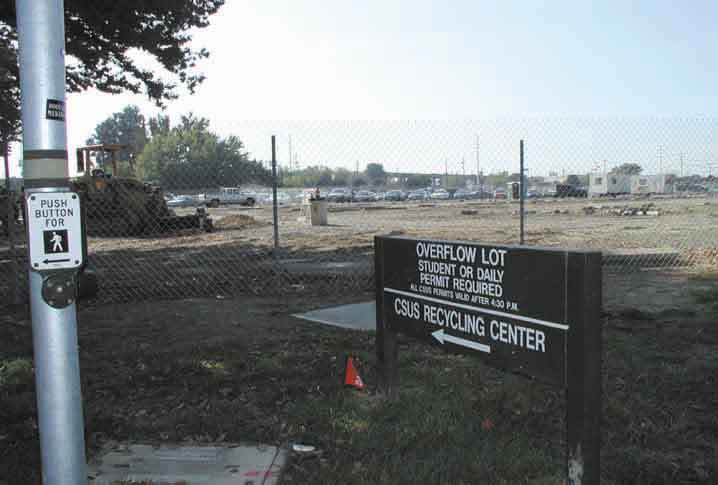Overflow parking lost to project
Image: Overflow parking lost to project:A fence surrounds 175 parking spaces in the south overflow lot. Photo by Levi Ziller/State Hornet:
November 6, 2001
Construction crews closed off a portion of Sacramento State?s overflow parking lot Monday morning, increasing the total number of parking spaces lost to various projects in the past month to 450.
Approximately 175 spaces will be lost as the University begins construction on a new Regional and Continuing Education Building on the lot at the south end of campus, said Facilities Planning Director Ron Richardson. An additional 275 spaces were lost Oct. 15 when a portion of Parking Lot 4 was closed for construction of a second parking structure.
The loss of spaces is not expected to have a large effect on students for the remainder of the semester, said University Transportation and Parking Services Manager Nancy Fox. Officials researched the amount of available parking during the University?s peak parking hours, 11 a.m. to 1 p.m., and found plenty of spaces available.
“Even with (the Lot 4 closure), we have had over 300 parking spaces available during peak parking times,” Fox said. “We still should have 125 spaces available.”
More of a concern for Sac State is what will happen during coming semesters, when a new flock of students come to campus looking for parking. Fox said the initial weeks of the spring 2002 semester will likely be crowded, but with typically lower enrollments than fall semesters, it should eventually thin out.
“I would imagine the first few days might be a challenge,” Fox said. “Parking will feel tighter, but it will be available to everyone in the spring.”
Next fall, Fox said, is when the real problems could occur. The 175 overflow lot spaces will be gone for good, and the 1,000-space parking structure is a one-year project, meaning there is no contractual obligation to finish before October 2002.
With fall enrollment numbers expected to be high, and an additional portion of the overflow lot being dedicated to the construction of Modoc Hall in late spring 2002, Fox said the University could resort to off-campus parking sites, from which students would be shuttled to campus, as a way to get students to class.
“We?ll get through the spring OK, but we may have to look at some remote parking sites in the fall if the parking structure isn?t finished,” Fox said.
Richardson said having the parking structure completed in time for the fall 2002 semester is a possibility.
“They have a year to build it, but they think they might be able to get it done faster,” Richardson said.
University officials have spoken to the contractors in charge of the parking structure about speeding up the building process, Fox said.
“It is our hope that we may be able to accelerate (the project) to open it up sooner,” Fox said.
The University is also exploring options to pave existing areas on campus to provide additional parking, Fox said. Whether that will happen will not be known until costs are determined, she said.
Fox said with all the new projects going up on campus, it?s possible there won?t really be relief until a planned third parking structure is erected on campus. That project is on hold until a proposed parking fee increase, which would nearly double semester parking fees over a three-year span beginning in fall 2002 and would be used to fund the structure, is approved by the California Faculty Association and the California State Employees Association.
Should the fee increase not be approved, the University would have to find other ways to ease the parking situation, Fox said.





























































































































